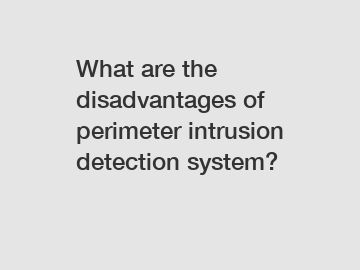Mar. 26, 2024
Perimeter intrusion detection systems (PIDS) are widely used in various industries and sectors to enhance security measures. These systems work by detecting any unauthorized entry into a designated area and alerting security personnel. While PIDS are beneficial in many ways, there are some disadvantages to consider as well.
Limited coverage range.
One disadvantage of PIDS is their limited coverage range. Depending on the type of system used, PIDS may only cover a certain distance or area. This means that there may be blind spots where intruders could potentially enter undetected. It's important to carefully assess the coverage range of a PIDS before implementing it to ensure that all potential entry points are adequately monitored.

False alarms.
Another drawback of PIDS is the potential for false alarms. Environmental factors such as weather conditions, wildlife, or even human error can trigger false alarms, leading to unnecessary disruptions and confusion. False alarms can also desensitize security personnel, causing them to ignore genuine threats. It's essential to regularly test and calibrate PIDS to minimize the risk of false alarms.
High cost.
PIDS can be costly to install and maintain, which can be a disadvantage for organizations with limited budgets. In addition to the initial installation costs, PIDS require ongoing maintenance and monitoring to ensure proper functioning. This can add up over time, making PIDS a significant investment for some organizations. It's important to consider the long-term costs associated with PIDS before making a purchasing decision.
Complexity.
PIDS can be complex systems that require specialized knowledge to operate effectively. Training security personnel on how to use and interpret PIDS data can be time-consuming and expensive. Additionally, troubleshooting and resolving issues with PIDS may require expertise that is not readily available within an organization. It's crucial to have a plan in place for managing the complexity of PIDS to ensure that they are used effectively.
Interference.
Interference from external sources such as electronic devices or radio signals can disrupt the functioning of PIDS, leading to false alarms or missed alerts. This can be especially problematic in areas with high levels of electromagnetic interference, such as near industrial equipment or power lines. It's important to consider potential sources of interference when installing PIDS and take steps to mitigate their impact.
In conclusion, while perimeter intrusion detection systems have many benefits, there are also some disadvantages to consider. These include limited coverage range, false alarms, high cost, complexity, and potential interference. It's important to weigh these disadvantages against the benefits of PIDS and carefully consider whether they are the right security solution for your organization. If you have any questions or would like to discuss PIDS further, please do not hesitate to contact us. We are a trusted PIDS supplier and are always happy to help.
If you are looking for more details, kindly visit Buried Cable Detection Systems, fiber optic intrusion detection system, RF970 precise positioning type fiber.
Previous: None
Next: None
If you are interested in sending in a Guest Blogger Submission,welcome to write for us!
All Comments ( 0 )